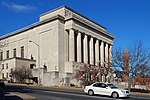Worcester Art Museum

The Worcester Art Museum, also known by its acronym WAM, houses over 38,000 works of art dating from antiquity to the present day and representing cultures from all over the world. WAM opened in 1898 in Worcester, Massachusetts, and ranks among the more important art museums of its kind in the nation. Its holdings include some of the finest Roman mosaics in the United States, outstanding European and American art, and a major collection of Japanese prints. Since acquiring the John Woodman Higgins Armory Collection in 2013, WAM is also home to the second largest collection of arms and armor in the Americas. In many areas, it was at the forefront in the US, notably as it collected architecture (the Chapter House, 1932), acquired paintings by Monet (1910) and Gauguin (1921), presented photography as an art form (1904). The Worcester Art Museum also has a conservation lab and year-round studio art program for adults and youth.
Excerpt from the Wikipedia article Worcester Art Museum (License: CC BY-SA 3.0, Authors, Images).Worcester Art Museum
Salisbury Street, Worcester
Geographical coordinates (GPS) Address Website External links Nearby Places Show on map
Geographical coordinates (GPS)
| Latitude | Longitude |
|---|---|
| N 42.273007 ° | E -71.802029 ° |
Address
Worcester Art Museum
Salisbury Street 55
01605 Worcester
Massachusetts, United States
Open on Google Maps











